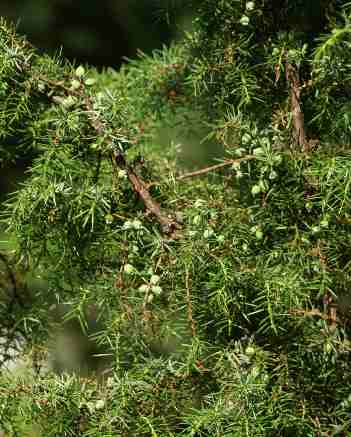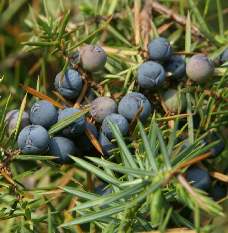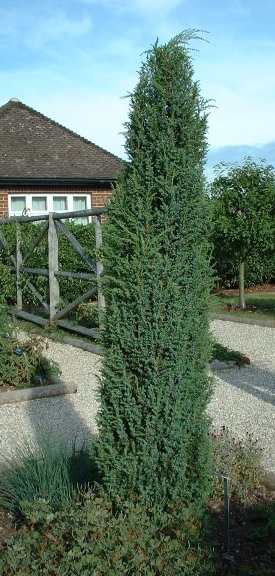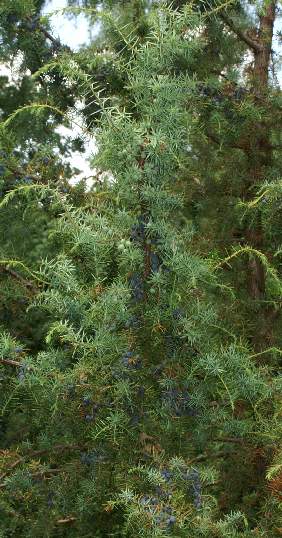| pharmaceutical | Fructus Juniperi, Pseudofructus Juniperi, Baccae Juniperi
|
| Albanian | Dellinjë e rëndomtë, Dëllinja, Dullinjë
|
| Arabic | عرعر
|
| عَرْعَر
|
| Arar
|
| Aramaic | ܒܪܘܫ, ܓܡܙܘܙ, ܕܦܪܢ, ܫܚܝ
|
| Barush, Gamzuz, Dapran, Shahi
|
| Armenian | Արտուճ
|
| Ardoog, Artuch
|
| Azeri | Ardıc
|
| Ардыҹ
|
| Basque | Iñibre, Ipuru
|
| Belarusian | Ядловец
|
| Iadlovec
|
| Breton | Jenevreg-boutin, Greun jenevra
|
| Bulgarian | Хвойна
|
| Khvojna
|
| Catalan | Ginebró, Càdec (Juniperus oxycedrus)
|
Chinese
(Mandarin) | 杜松 [dù sōng]
|
| Du song
|
| Croatian | Borovica
|
| Czech | Jalovec, Jalovčinky, Jalovec obecný
|
| Danish | Enebær, Junipero
|
| Dutch | Jeneverbes
|
| English | Juniper
|
| Esperanto | Junipero, Juniperbero
|
| Estonian | Harilik kadakas, Kadakamarjad
|
| Farsi | سروکوهی
|
| Sarv Kuhi
|
| Finnish | Kataja, Katajanmarja, Kotikataja
|
| French | Genévrier, Genièvre
|
| Gaelic | Aiteil, Ailtinn, Aitiol, Dearc-aitinn
|
| Galician | Enebro, Xenebro
|
| Georgian | ღვია
|
| Ghvia
|
| German | Wacholder, Machandel, Kranawitt
|
| Greek | Άρκευθος
|
| Arkevthos
|
| Greek (Old) | Ἄρκευθος, Μνησίθεος, Κεδρίς
|
| Arkeuthos, Mnesitheos, Kedris
|
| Hebrew | ג׳וניפר, ערער
|
| עַרעָר, ג'וּנִיפֵר
|
| Ar-ar, Arar, Guniper, Juniper
|
| Hungarian | Boróka, Borókabogyó
|
| Icelandic | Einiber, Einir
|
| Italian | Ginepro, Coccola di ginepro
|
| Japanese | セイヨウスズ, セイヨウトショウ, ジュニパー
|
| Seiyō-suzu, Seiyo-suzu, Seiyō-toshō, Seiyo-tosho, Junipa
|
| Kazakh | Арша
|
| Arşa
|
| Korean | 곱향나무, 주니퍼, 쥬니퍼
|
| Kophyang-namu, Junipeo, Jyunipeo, Chunipo, Chyunipo
|
| Latin | Iuniparium, Iuniperum, Zyniperum
|
| Latvian | Paegļi, Zviedrijas kadiķis; Kadiķa ogas (juniper berries)
|
| Lithuanian | Paprastasis kadagys
|
| Macedonian | Боровинка, Клековача, Смрека
|
| Borovinka, Klekovača, Smreka
|
| Mongolian | Арц
|
| Arts
|
| Nepali | धुपी, फार
|
| Dhupi, Phar
|
Newari
(Nepalbhasa) | धूपीसिं
|
| Dhupisin
|
| Norwegian | Einer
|
| Polish | Jałowiec pospolity; Jagody jałowca (juniper berries)
|
| Portuguese | Junípero, Junipo; Zimbro (Juniperus oxycedrus)
|
| Provençal | Genèbre, Janebre, Genibrièr
|
| Romanian | Ienupăr
|
| Russian | Можжевельник
|
| Mozhzhevelnik
|
| Sanskrit | Hapusha
|
| Serbian | Клека, Вења, Фења, Смрековина, Смрека, Шмрца
|
| Kleka, Venja, Fenja, Smrekovina, Smrekna, Šmrca
|
| Slovak | Borievka obyčajná, Borievka
|
| Slovenian | Brin, Brinove jagode
|
| Spanish | Enebro, Cedro, Bayas de enebro, Junípero, Nebrina
|
| Swahili | Mreteni
|
| Swedish | En, Enbär
|
| Tibetan | ཤུག་པ་, ཤུགས་པ་
|
| Shug-pa, Shugs-pa
|
| Turkish | Ardıç yemişi, Ephel
|
| Ukrainian | Ялівець звичайний, Яловець звичайний
|
| Yalivets zvychajnyj, Yalovets zvychajnyj
|
| Uzbek | Archa
|
| Арча
|
| Vietnamese | Cây bách xù
|
| Cay bach xu
|
| Welsh | Merywen
|
| Yiddish | קאַדיק, יאַלאָװעץ
|
| Kadik, Yalovets
|










